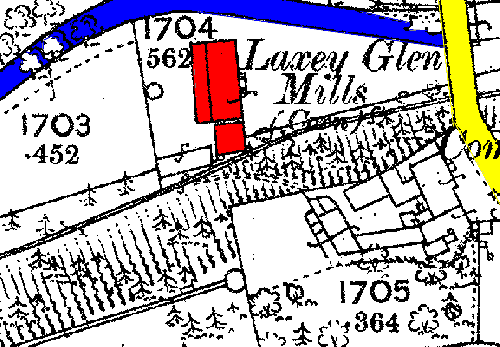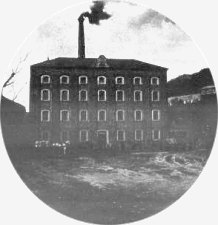
From 1868 O/S Plan XI/2 - SC 432844

Laxey Glen Mill 1899
|
From 1868 O/S Plan XI/2 - SC 432844 |
|
[From Mona's Herald, Wednesday, 28th June, 1899]
LAXEY GLEN MILLS. This mill is one of the most complete in its structure, internal arrangements, and machinery that could be devised. The main building is about 72 feet in length. 36 feet wide, and four storey high, each floor being 10 feet in the clear. It was built in 1860, under the supervision of the late Robert Casement, the engineer of the "Laxey Big Wheel" fame. The walls of the building itself is a masterpiece of rubble stone masonry. The contract for the machinery was placed with Messrs McAdams, engineers, of Belfast. A speciality of these engineers was at that time turbine water wheels, one of which was introduced here for motive power. The wheel itself would appear only a miniature, it being only about 22 inches in diameter running horizontally at a speed of over 300 revolutions per minute, and giving out a force equal to about 40 horse power.
The mill started on its course in February, 1861, and under the able management of the present proprietor all the defects in the construction of the machinery were pointed out and remedied so that as far as the then present day milling was concerned it was soon as perfect as human genius could make it. Soon it was discovered that steam power would be necessary to supplement the water in the dry season. And the arrangement for coupling the both powers was so nicely adjusted that no jarring was perceptible and no water was allowed to run waste. It enjoyed a monopoly of the trade on the Island, and also to the North of England, for very many years.
Change seems to mark all things, and flour milling was not exempt. The boom for rollers to supersede stone grinding came along so rapidly that in a very short time it was evident that flour manufactured by the new process was leading in the market, and it became evident that unless the new principle was adopted that the concern must drop behind and fall into disuse and ruin. The then owner not being disposed to undertake the expense of reconstruction, he determined to sell the mill, and, having fixed a price, the manager seeing the possibility of continuing under the new system, purchased the concern, and shortly afterwards contracted with Messrs Carter's, of London, for a new roller mill plant of the newest type, and on the most approved principle.
The whole of the internal arrangements were reconstructed for the manufacture of flour, and to the credit of the present owner, Mr Thos. Corlett, M.H.K., assisted by his two energetic sons, the Island can boast of a flour mill which for its size and capacity of output and quality cannot be excelled, and any new machinery introduced for the more perfecting of milling is being noted, and, when practicable, adopted by them, so that we have in our midst one of the best flour mills of to-day, and for comparison will stand equal with mills of much greater pretensions. We lately had to chronicle the return of Mr T. S. Corlett from a visit of the greater world of America, where, undoubtedly, he would examine the latest improvements in milling, during his stay, and would have opportunity of knowing whether the boastful American was much in advance of the Island in the manufacture of flour, and thus benefit by his travels over the ocean.
Scarffe suggests that the builder of the Mill was John James Moore of Baljean, who had a few years earlier built the viaduct carrying the nearby New Road across the valley.
Andrew Scarffe The Story of Laxey Flour The Manx Experience 2010 ISBN 978-0-9564553-2-1
|
|
||
| Water powered Mills etc | ||
|
|
||
|
Any comments, errors or omissions gratefully received The
Editor |
||